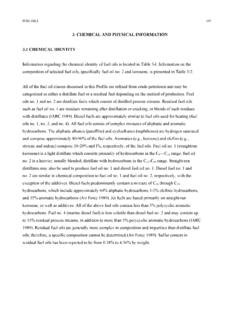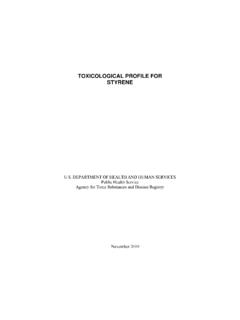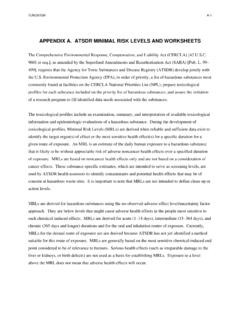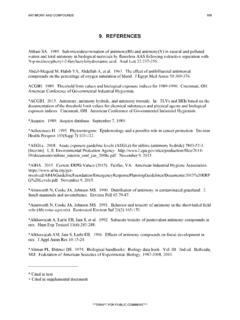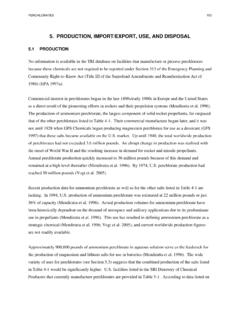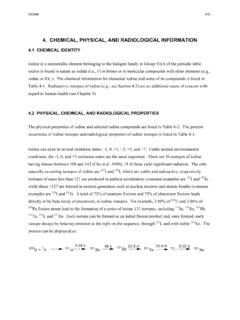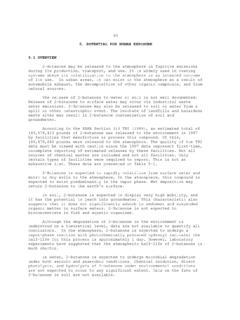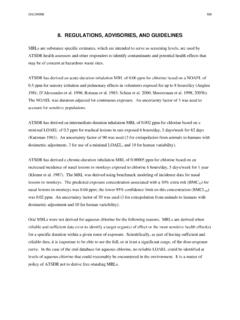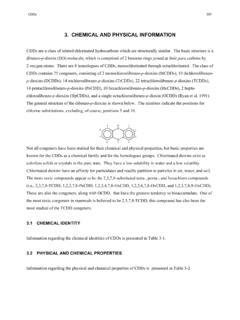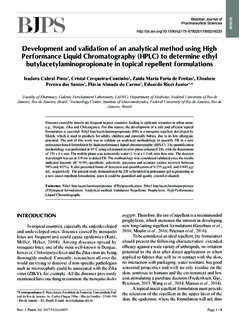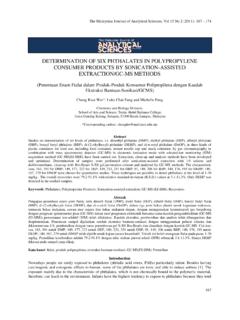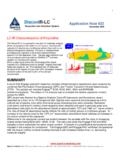Transcription of 7. ANALYTICAL METHODS - Agency for Toxic …
1 PCBs 595. 7. ANALYTICAL METHODS . The purpose of this chapter is to describe the ANALYTICAL METHODS that are available for detecting, and/or measuring, and/or monitoring PCBs, its metabolites, and other biomarkers of exposure and effect to PCBs. The intent is not to provide an exhaustive list of ANALYTICAL METHODS . Rather, the intention is to identify well-established METHODS that are used as the standard METHODS of analysis. Many of the ANALYTICAL METHODS used for environmental samples are the METHODS approved by federal agencies and organizations such as EPA and the National Institute for Occupational Safety and Health (NIOSH). Other METHODS presented in this chapter are those that are approved by groups such as the Association of Official ANALYTICAL Chemists (AOAC) and the American Public Health Association (APHA).
2 Additionally, ANALYTICAL METHODS are included that modify previously used METHODS to obtain lower detection limits, and/or to improve accuracy and precision. Methodology for PCB analysis includes several steps: sample collection and storage, extraction, cleanup, and determination (EPA 1995c, 1999k; Hess et al. 1995). Care must be taken to assure that the sample collection follows quality assurance protocols and that equipment and containers are free from contamination. Most sample collections are by grab sampling; however, PCBs may be concentrated from water or air onto sorbents. PCBs are typically separated from the sample matrix by solid-phase extraction (SPE), separatory funnel extraction, continuous liquid/liquid extraction (CLLE), Soxhlet extraction, or Soxhlet/Dean-Stark extraction.
3 PCBs may be difficult to extract from oily matrices in which they are soluble. Some problems that may occur during extraction include evaporative losses during concentration, sorption onto labware, and contamination of samples. Cleanup steps are necessary to remove compounds that may interfere with the determination. Chromatography ( , gel permeation, silica gel, Florisil, activated carbon, high-performance liquid) is often used to remove matrix interferences, and sometimes to fractionate PCBs into several groups. Cleanup by chromatography has been used extensively to separate the non-ortho and the mono-ortho CBs from the remaining congeners before quantitative analysis (Hess et al.)
4 1995). The identification and quantitation of PCBs are most often accomplished by gas chromatographic (GC) techniques. Capillary or high resolution gas chromatography (HRGC) columns capable of separating a substantial proportion of the congeners are indispensable, and GC detectors possessing high selectivity and sensitivity for the PCBs are required. The more universal and less sensitive flame-ionization detector (FID) is used much less often than the electron capture detector (ECD), which has exceptional sensitivity to multiply chlorinated compounds. The mass spectrometer-selected-ion-monitoring (MS-SIM) or ion-trap mass spectrometer (ITMS) detectors have sensitivities somewhat lower than ECD, and they have even greater selectivity for PCBs and can PCBs 596.
5 7. ANALYTICAL METHODS . distinguish and individually measure homologs that may coelute on a particular HRGC column (EPA. 1999k). Some METHODS in use are multi-residue METHODS in which PCBs along with many other analytes such as pesticides, are determined. In general, PCB METHODS analyze for Aroclor mixtures, PCB homologs, or individual PCB congeners. Until recently, packed column GC/ECD was used most often for the determination of PCBs as Aroclor mixtures. The Webb-McCall technique was used for quantitation. The weight percent and homolog identification were determined for several Aroclors. Response factors were generated to calculate the amount in each sample peak; with packed columns, each peak contains several congeners.
6 The amounts found in each sample peak were then summed (Webb-McCall 1973). Alternately, the total area in the Aroclor region of the chromatogram was used for quantitation. However, Aroclor analyses are estimations that are prone to error as a result of the subjective assignment of Aroclor speciation and response factors. Also, the practice of comparing CB patterns in environmental samples with those of technical mixtures can be misleading since mixtures emanating from different sources are mixed at differing rates by diffusion, evaporation, and adsorption onto solids. Many congeners are metabolized, while others bioconcentrate in lipophilic material. Therefore, the final pattern in the environment is often highly modified and may not resemble the original commercial formulation or mixture of formulations (Draper et al.)
7 1991; Duinker and Hillebrand 1979; Hess et al. 1995). The maximum detection limits (MCLs) for Aroclors vary in the range of g/L in water and 57 70 g/kg in soils (EPA 1995c). Another approach is to determine PCBs by level of chlorination (or homolog group). One PCB for each homolog (isomer group) is typically used for calibration. Total PCB. concentration is obtained by summing isomer group concentrations (Alford-Stevens et al. 1986). However, since the congener distribution is not determined with this method, an accurate calculation of PCB Toxic equivalency (TEQ) can not be accessed. Recently, capillary or HRGC has made it possible to achieve lower detection limits and better separation of individual PCB congeners for quantitation (Frame 1997; Mullin et al.
8 1984; Newman et al. 1998), although complete separation of all PCB congeners on a single column has not yet been achieved (Duebeleis et al. 1989). The commonly used capillary columns (DB-5, C-18, DB-1701, SE-54, SIL-8, SP-2330, and CP-SIL-8) provide poor or no resolution for the following groups of congeners: 15/18, 28/31, 49/52, 66/95, 77/110, 84/90/101, 118/149, 138/163/164, 105/132/153, 170/190, and 182/187 (Liem 1999; Schantz et al. 1993b). Nevertheless, the trend is toward congener-specific analysis by HRGC. Recent advances include ANALYTICAL METHODS that are able to quantify individual PCBs congeners to enable TEQ calculations (EPA 1999k; Frame 1999; Patterson et al. 1994). EPA Method 1668 (Revision A ) is the current methodology used to measure individual PCB.
9 Congeners in water, soil, sediment, and tissue by HRGC/high resolution mass spectrometry (HRMS). PCBs 597. 7. ANALYTICAL METHODS . (EPA 1999k). Estimated detection limits (EDL) of selected PCB congeners range from 109 to 193 pg/L. for water and 11 19 ng/kg for soil, tissue, and mixed-phase samples. EDLs are listed in Table 7-1 for EPA Method 1668 (Revision A; EPA 1999k). This method has been used to measure specific PCBs in EPA projects such as the assessment of PCBs in fish consumed by four Native American tribes in the Columbia River Basin in Washington state (EPA 1996f). As for all ANALYTICAL METHODS , determining the quality and usability of Aroclor, PCB homolog, or specific congener data by formal data validation procedures is recommended; EPA has developed data validation guidelines for HRGC/ECD Aroclor data and HRGC/LRMS (low resolution mass spectrometry) PCB specific congener data (EPA 1994h, 1995g).
10 BIOLOGICAL SAMPLES. The quantitation of PCBs in biological samples usually consists of three distinct steps: extraction of PCBs from the sample matrix by a solvent or a combination of solvents; cleanup of PCBs from impurities on single or multiple columns; and finally, quantitation by GC with a suitable detector. A summary of some available METHODS for biological samples is shown in Table 7-2. PCBs are extracted from blood or serum by solvent extraction techniques using hexane (EPA 1980;. Needham et al. 1980), benzene (Mes et al. 1994, 1995a, 1995b, 1995c), or mixed solvents such as hexane/ethyl ether (Koopman-Esseboom et al. 1994b; Luotamo et al. 1985; Needham et al. 1981), or by solid phase micro-extraction techniques (Poon et al.)
